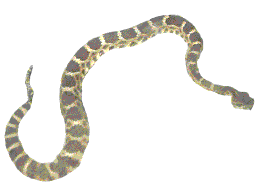 Western Rattlesnake
Western Rattlesnake
Crotalus viridis
 Western Rattlesnake
Western Rattlesnake
Crotalus viridis
Adults grow up to 5 feet long or more. The color varies considerably between individuals, ranging from shades of tan, green, gray or black with contrasting diamond-shaped markings on the back. The tail is always tipped with at least one button and individuals may have a large string of rattles.
The western rattlesnake occurs in the valley but is found in largest numbers in brush and chaparral areas of the foothills. Food is chiefly rodents such as rats, mice and squirrels. It also feeds on birds, lizarrds, and rarely other snakes.
The rattlesnake, this area's only poisonous reptile, is the subject of much misinformation and folklore Unlike most othe snakes, it is slow, even lethargic, and not usually aggressive unless cornered. It hibernates from about October until the air reaches about 70 degrees F.
Rattlesnake young, born alive and equipped with venom, have a blunt horny button at the tip of the tail. All other western snakes except the boas have slender, tapered tails.